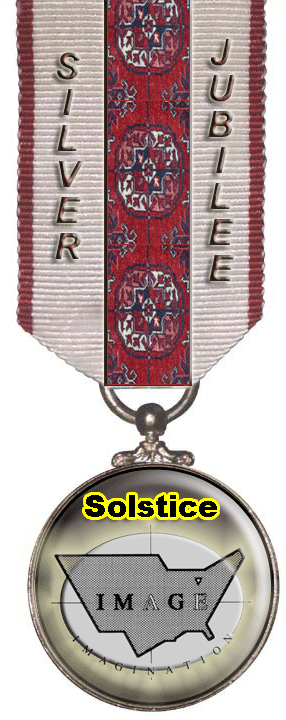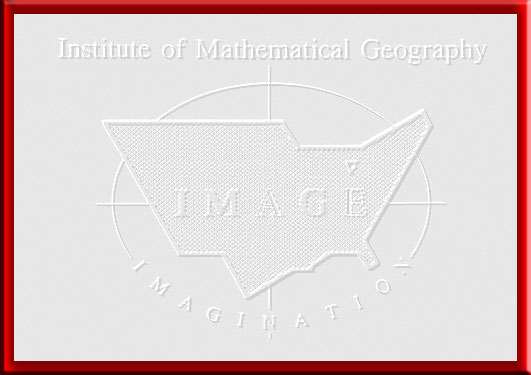|
Here is a look at what the Menger Sponge is and
how to
create it (1, 2). A fractal is generated
by a seed (geometric, algebraic), and an algorithm that provides the
rule for
growing or shrinking the seed by some fraction.
The rule is then applied to each new part of the
structure to generate
more, smaller copies of the original. At
each stage, if we zoom in to the structure, it appears to look like a
previous
stage. This self-similarity can be exact
or statistical.
Karl Menger produced the 3-D fractal that bears
his name in
1926 in his research in topological dimension (2).
It is a 3-D version of the 2-D Sierpinski
Carpet, and the 1-D Cantor Set, created by a subtractive process. Start with a cube (stage 0, or the seed); by
subdividing each edge into three equal parts you will divide each face
into
nine equal squares, and thus divide the cube into 27 equal cubelets. Push out the central cubelets on each face
and the interior center cubelet to obtain the stage 1 structure, like a
Rubik’s
Cube with centers drilled out. Repeat
the process with each of the 20 small cubes left, producing 20 x 20 =
400 smaller
cubes, for stage 2. Repeat ad infinitum,
to approach an object with “infinite surface area and zero volume” (2). In practice, we build by additive modules,
rather than trying to carve out cubes from a given large cube!
But how many of us have actually tried building
stages of
the Sponge in real 3-D space? This year
there was an international group-building effort organized, called the
MegaMenger Sponge project (3). The goal
was to try to build a stage 4 Menger Sponge, by having groups around
the world
build stage 3 sponges, and link them at least virtually via the
internet to
create a stage 4, as a mathematical crowdsourcing event.
The project was conceived and implemented by
Laura Taalman
(James Madison University, VA and Mathematical Association of America
Ambassador) and Matt Parker (Queen Mary University, London UK and Think
Maths)
and circulated via the website megamenger.com (5).
Cubes would be built using folded business
cards, and linked together to form higher stages. It
was timed to coincide with the Celebration
of the Mind gatherings in honor of Martin Gardner, held in late October.
I first found out
about the MegaMenger Sponge project
(megamenger.com) from a distribution list email, but had been part of
building
one on prior occasions. The use of
business cards to create cubes and attach the cubes together has been
known
since way before YouTube (where you can get various video tutorials).
The first time was many years ago when Robert
Messer at
Albion College in Albion, MI had his students build one; they got
halfway to stage
3. Some years later, Ada Dong did the
same, getting to stage 2 with her class in a summer program for high
school
students at Lawrence Technological University.
This effort was recreated by my Lawrence
Technological University Math
Club students, and is an ongoing project.
I joined the group at the Museum of Mathematics (MoMath) in New York City, while on a weekend
visit to see my sister. Knowing I was
visiting for the weekend, I had checked the MoMath website for
activities (4).
I discovered their Menger Sponge project and knew I had to take my
cousin, with
whom I was staying. She is my arts
guide, and I am her math guide.
A diverse group of people, from 9 year olds to
senior citizens,
gathered on October 25th on the 0th floor of
MoMath
(that’s the lower level) to assemble the different stages.
People could wander in and out all day to
look or participate. There were directions
and there were helpful human guides. Directing
it all, refreshing supplies, and caring for all aspects of the project,
was
Laura Taalman, this year’s Mathematician in Residence at MoMath!
It was well organized. There were tables for
assembling each
stage, from 0 to 3. Directions were on
each table, and whiteboards gave the sequence: fill the basket at the
end, move
the stage 0’s to the stage 1 table, and iteratively continue the
process
(as shown in the accompanying Figures). Plain
business
cards were supplied, as well as printed cover cards.
The cover cards were to mask the tabs from
construction and make a smooth surface; they were printed with a
Sierpinski
carpet on one side. A nice touch.
By late morning
when we arrived, many people were busy at
work. We sat at the beginner’s table
(fold cards, build stage 0 cubes, Figures 1a and 1b).
My cousin caught on quickly, and we both enjoyed the conversation with
others at the table. And that provided
some unexpected, gratifying networking, another benefit of gathering
together
people with mathematical curiosity.
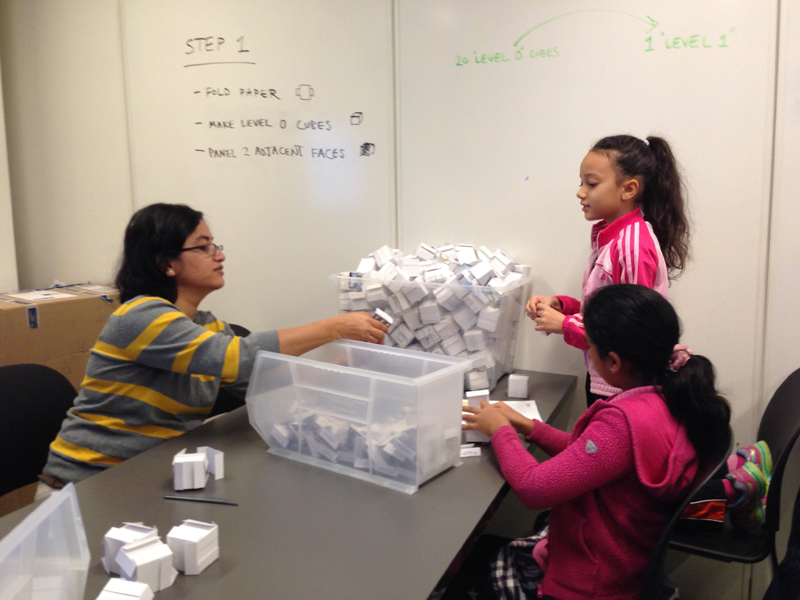
Figure 1a. Step
1 in creating the MegaMenger Sponge. Building
stage 0 cubes.
|
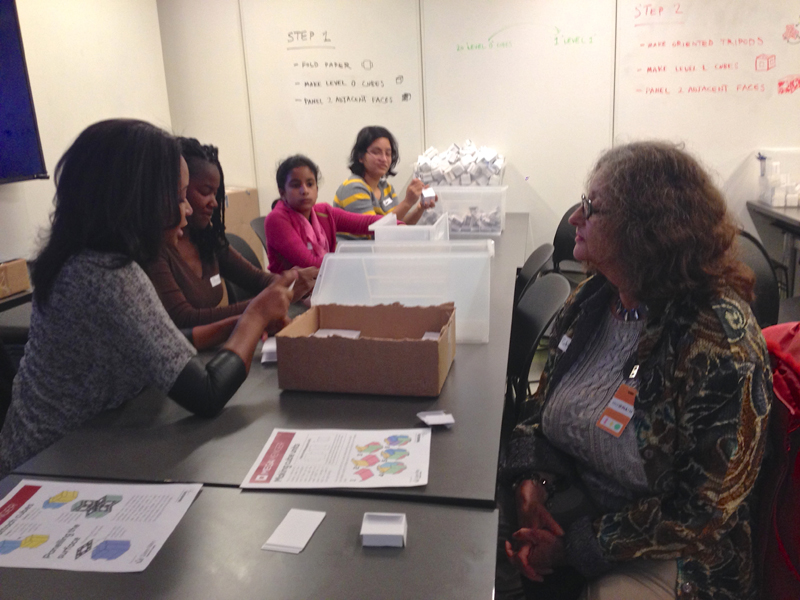
Figure 1b. Step 1 in creating
the MegaMenger Sponge. Building stage 0 cubes.
|
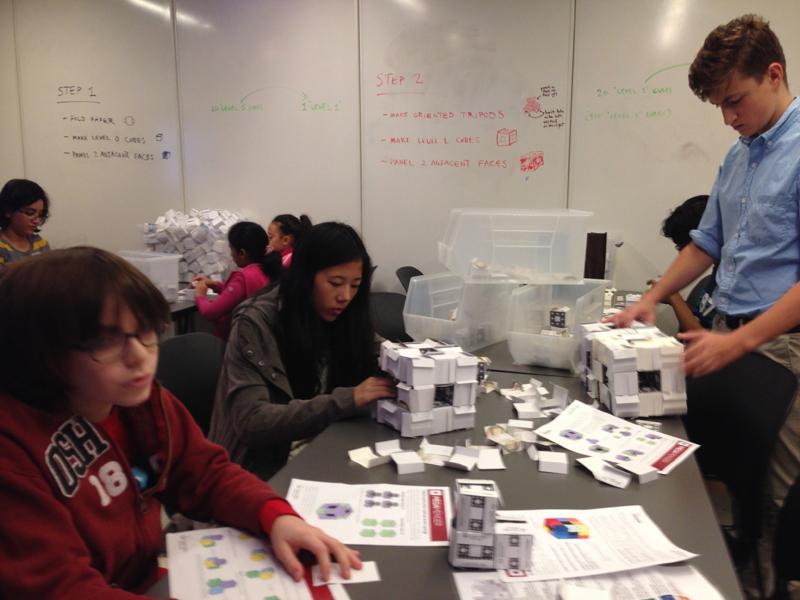
Figure 2. Step 2 in creating
the MegaMenger Sponge. Building stage 1.
|
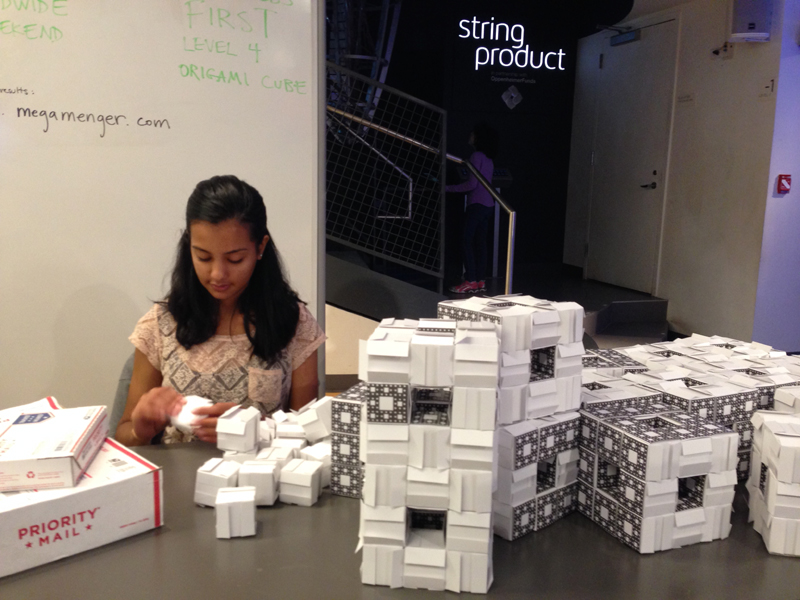
Figure 3. More stage 1 blocks.
|
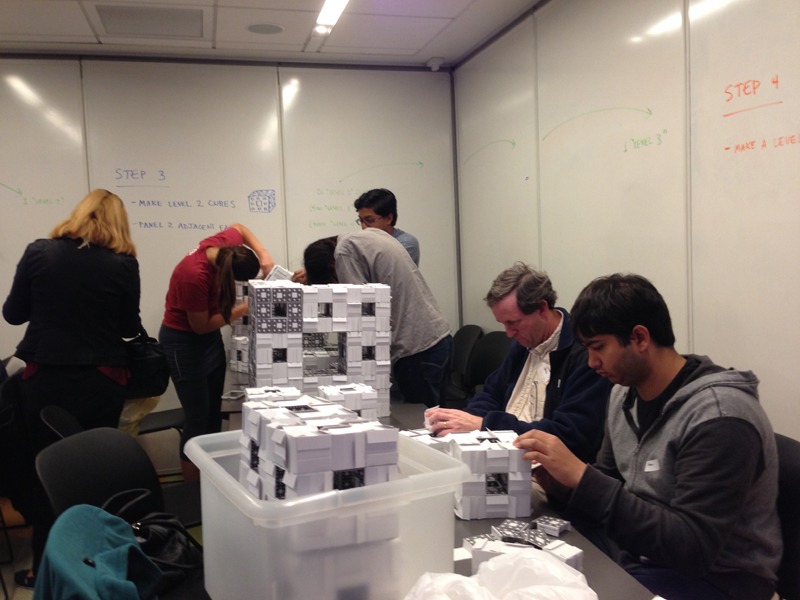
Figure 4. Step 3 in creating the
MegaMenger Sponge. Attaching stage 1 blocks.
|
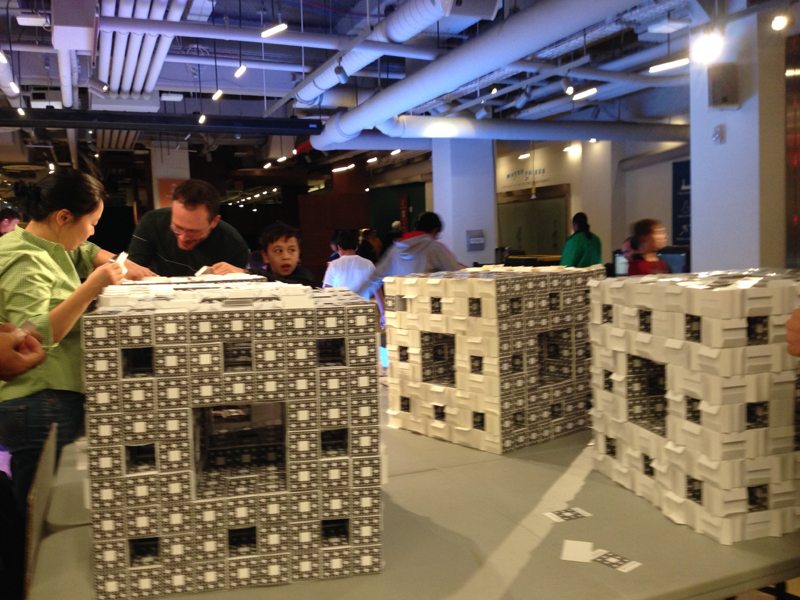
Figure 5. Step 4 in creating
the MegaMenger Sponge. Cover cards on stage 2.
|
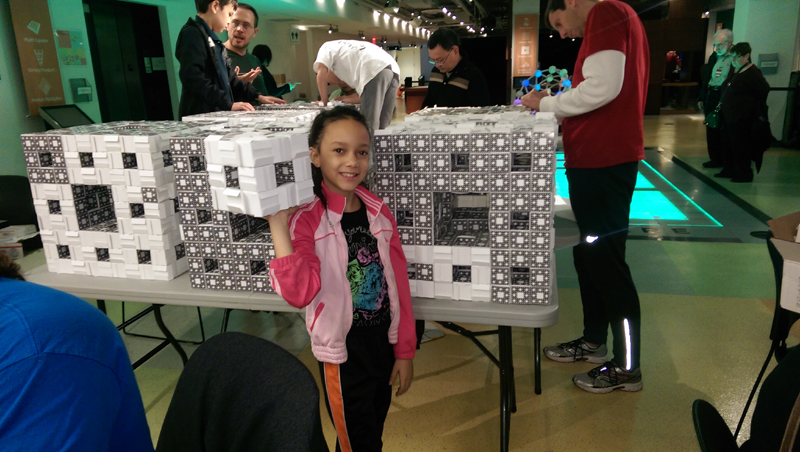
Figure 6. More stage 2 blocks,
getting ready to attach.
|
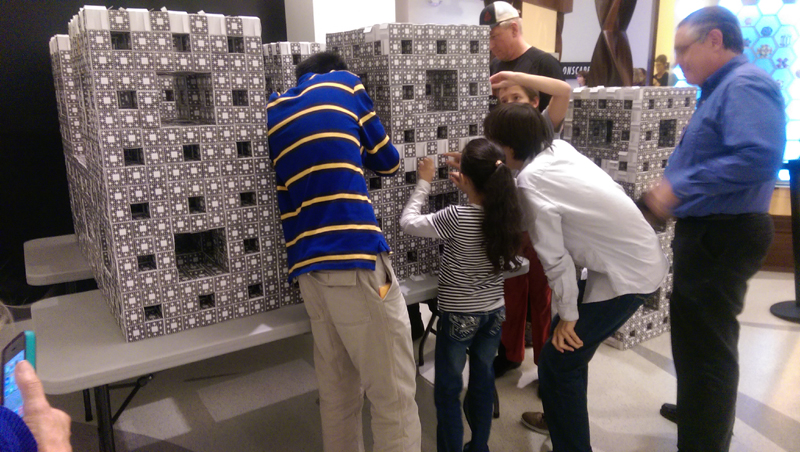
Figure 7. Step 5 in creating
the MegaMenger Sponge. Attaching stage 2 blocks.
|
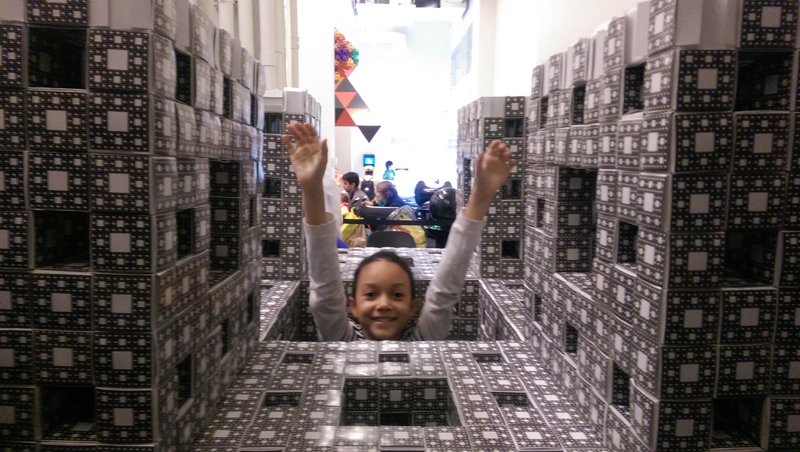
Figure 8. Step 6 in creating
the MegaMenger Sponge. Attaching stage 2 blocks. Whoopee!
|
I gave information
about the AMC8 contest to a woman whose
9-year-old daughter and friend were busy making cubes. A high
school teacher and I talked about books
on origami, and also information on fractals. (In a nice
coincidence, we crossed paths later
in the afternoon while walking the High Line, a former elevated railway
now a
walking trail and park by the Hudson River—we had geographic as well as
mathematical curiosity.) One of the
other participants mentioned that he had used a stage 2 Sponge as a
coffee
table for a while. I did not ask what
happened to it.
The day produced several stage 2 sponges, as
well as much
fun and learning experience for the participants. Laura
Taalman sent participants an email,
calling for those who could come back to continue to build during the
week, and
also on the next weekend. Photos show
some of the results.
Here is a sample quiz.
Given:
Stage 0 takes 6 business cards to make (without
the cover
cards for a smooth surface); stage 1 takes 20 of the stage 0 cubes;
stage 2
takes 20 stage 1’s; stage 3 takes 20 stage 2’s; and stage 4 takes 20
stage 3’s.
Find:
a) How many business cards are needed for each
of stages 1 –
4? (Ignore the covers that make the finished product look smooth.)
b) How much does each stage weigh
(approximately)?
c) How many cards are needed for covering the
outer surface
(to smooth the surface) of each stage 1 - 4?
d) How much weight has been added to the object
by the
covering cards at each stage?
REFERENCES
1. http://en.wikipedia.org/wiki/Fractal
2. http://en.wikipedia.org/wiki/Menger_sponge
3. www.megamenger.com
4. www.momath.org
5. Sponsors include Queen Mary University,
Museum of Math,
and the Manchester (UK) Science Festival.
*Professor Emerita of
Mathematics, Lawrence
Technological University, Southfield,
MI. favro@ltu.edu
^The author wishes to thank Judy and Marcelle Villeneuve for sharing
some photos of the event.
|
